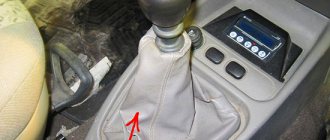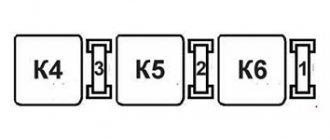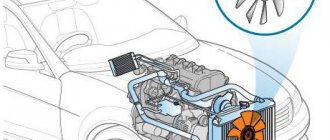An automatic transmission is an important and structurally complex unit in a car. Proper operation and high-quality maintenance of automatic transmissions helps to avoid breakdowns, thereby extending the service life.
However, even if you adhere to all the rules and recommendations for operating the machine, various types of malfunctions may occur. In this case, correct diagnosis of the automatic transmission is necessary, which will help to accurately identify this or that breakdown.
A common automatic transmission malfunction is the inability to engage reverse gear. Below we will take a closer look at this problem and how to solve it.
Causes of the malfunction and what to do if the reverse gear on the automatic transmission is lost
I hope that no one has lost reverse gear in an automatic transmission when a dump truck is moving in reverse towards you in a small alley. But this happened to me. Well, at least he was walking at a slow speed. I managed to run out of the car, and together we pushed my car back. But the transmission never started.
I started to figure out what was going on. And today I’ll tell you why the reverse gear of an automatic transmission stops working and how to fix the breakdown.
- Design and principle of operation of reverse gear
- Causes of reverse gear malfunction
- Electronic part
- Automatic transmission oil level
- Release bearing wear
- Clutch fork
- Clutches
- Pump
- What to do if the reverse gear of the automatic transmission on a Toyota Camry does not engage
- Conclusion
Design and principle of operation of reverse gear
First, let's look at the principle of operation of reverse gear on an automatic transmission. Manufacturers have introduced a special lock into modern automatic transmissions. This is done by the brake band. Thanks to it, the driver does not feel sharp jolts from the machine when switching from the “Forward” mode to “Reverse” or moving backward.
Attention! Before you start moving the car back, press the brake pedal, wait until the car comes to a complete stop and only then move the selector lever to “R” mode and press the gas pedal. Moving the lever to the “Reverse” position when moving forward will damage the automatic transmission.
So what happens in the automatic transmission when the driver moves the selector lever to “R” mode.
- The driver stops the car and moves the selector lever to “Reverse”.
- The signal goes to the ECU.
- From the electronic control unit it is transmitted to the corresponding solenoid valves. They open up.
- The oil enters the torque converter, accelerates and, under pressure, presses on certain clutch packs that communicate with the gears.
- The brake band clamps the remaining friction discs.
- Reverse motion is set.
- The car is moving backwards.
If some part is faulty, then the transfer may not take place or the automatic transmission will switch to reverse gear thoughtfully.
What to do, how to behave
Actually, there are no complex algorithms, but there are a few things to remember:
- If you notice that “R” is on, do not accelerate
- Don’t switch to “D” right away, it’s fraught!
- You need to stop and after a complete stop, switch to “DRIVE”
Why do you need to do it this way, and not immediately transfer from “R” to “D”? WE have already realized that in modern cars, when such an error occurs, neutral is switched on, in which you can roll, but you should not turn on DRIVE from it
Causes of reverse gear malfunction
Almost always, the reverse gear stops shifting properly due to driver negligence. And only in extreme cases due to a manufacturer’s defect or design defect.
Reverse speed disappears due to incorrect control of the automatic transmission by a novice car enthusiast. The problem will be with the reverse speed due to insufficient oil filling or untimely replacement.
We will analyze the causes of the malfunction in the following paragraphs. But first, write in the comments: did your reverse gear break down? And how did you deal with this problem?
Electronic part
The lack of reverse gear in the automatic transmission can be caused by a breakdown in the electronic control unit. The wire is broken or the electric valve is stuck. The solenoid does not work most often due to contamination of the valve body with used oil.
The problem may be a faulty temperature sensor. The electronics will not allow you to switch to another gear when the machine heats up weakly. The vehicle will only move in first or second speed.
It happens that the tracks in the ECU, which are responsible for transmitting the signal to the corresponding solenoids, have burned out.
Automatic transmission oil level
I would like to ask, how often do you check the transmission fluid level in your automatic transmission? Did you know that due to lack of oil in the automatic transmission, sufficient pressure is not generated. This means that the components cannot work properly.
Last but not least, we can talk about the wear of metal parts, for which oil is a protective element. First of all, the lack of lubricant will affect the operation of the mechanism and, of course, the gear shift to reverse gear.
Release bearing wear
The reasons for the non-working reverse gear of the automatic transmission may be wear of the release bearing. Typically manifests itself as a knocking or noise when pressing the pedal.
Unlike previous problems that were related only to reverse gear, in this case other speeds may not be included. The machine will remain motionless or move forward with a grinding noise.
In addition to the release bearing, this category includes clutch fork failures.
Clutch fork
The reason why the reverse gear of the automatic transmission is not working may be a broken clutch fork. If the fork does not work, the clutch will not engage. This means that the car will not move.
And it can break at any time, even while driving on the highway, creating an emergency situation. Therefore, it is important to carry out annual maintenance of the vehicle’s automatic transmission.
Attention! Install only original parts. Low-quality or cheap fakes will make you pay twice.
Clutches
If there is no reverse gear on the automatic transmission, then the corresponding clutches may be worn out. In this case, the car should not pick up speed above 2nd gear. Slipping occurs when the box is warm. When cold there are no signs of problems.
Pump
It will be difficult to solve the problem if the reverse gear of the automatic transmission does not work when the pump wheel is broken. In this case, the pressure in the entire machine drops. And, if the car moves forward and does not respond to pressing the accelerator, then the drum splines may be cut off.
You will have to pull the automatic transmission completely out of the car, disassemble and cut the torque converter. This is a labor-intensive and expensive procedure. At a service station, solving this problem can cost the car owner 11,000 rubles.
However, before you think that everything is bad, the reverse gear turns on blue, you need to check what really happened. In some cases, simply replacing the transmission fluid helps.
This procedure can be done by the driver himself or sent to a service center. The cost of replacing the lubricating fluid will cost the driver 2,500 rubles.
Tell us, what problems did you have with reverse gear?
How to access 5th gear gears
- Lower the gearbox until all the gearbox cover bolts are accessible. In its original state, the fastener is closed by the left side member. There is no way to unscrew the bolts from this position.
- Unscrew the fasteners. The cover is held on by 11 bolts. It is interesting that some of the bolts use a 13 head, the other part uses an 11 head.
- Disconnect the cover. Box oil will begin to leak. You need to place some kind of container under the cover to collect leaking lubricant.
Please note that the gearbox cover is seated on a gasket. When assembling the unit, you will need to use a new seal.
- We are inspecting the 5th gear synchronization mechanism.
To disassemble 5th gear, you need to unscrew the gear shift fork. The fork is held in place by 2 hex head bolts. By disconnecting the fork, you can remove the synchronizer and 5th gear gears. To remove the gears from the axles, you must first remove the locking rings.
All disconnected elements must be inspected for mechanical damage. Very often, circlips fly out in fifth gear, but it can also affect the fork and dampers.
If you couldn’t immediately repair the 5th gear of the Chevrolet Lacetti transmission, but you urgently needed the car, then it’s not a problem. You can freely operate the gearbox without fifth gear. You just need to remove from the housing all the gears that belong to the fifth speed. This is necessary so that the already inoperative synchronizer does not accidentally grind.
Below is an additional video, the author of which shows the entire process of disconnecting and revising the 5th speed on this car.
What to do if the reverse gear of the automatic transmission on a Toyota Camry does not engage
The hardest thing is for drivers of Toyota Camry and other passenger cars that have low ground clearance. Knocks out the reverse gear at an extremely unpleasant time. For example, when you are stuck on a dirt, broken road and are trying to drive out backwards.
If there is no reverse speed on the Toyota Camry, then you should call a tow truck, which will help you not to be lost for a long time on village roads. If such an incident occurred in the city, then you can try to solve the problem yourself.
If the car moves normally in all gears, but when moving from the “P” mode to the “Reverse” position or, conversely, to the “Forward” position, then you may simply have a lack of transmission fluid. Place the machine on a level surface and check the oil level. It will show that the fluid is below the desired level. Add grease.
If neither forward nor reverse gear works, then the torque converter has failed. This problem can only be solved at specialized service stations. Therefore, you need to contact the service. If you have some knowledge in the field of automatic transmissions or your friend is an experienced mechanic, then you can remove and disassemble the automatic transmission yourself in the garage and cure the “donut”.
If only reverse gear does not engage, but the car drives normally, then the friction coating on the brake band has worn out. Tightening the bolts to adjust the tape will not help you either. You will need to buy a new brake band and replace it.
After you buy the brake band, don't forget to buy additional oil, an oil filter, and new gaskets for the pan and seals for the drain and fill plugs. Because the oil will need to be changed. Possibly the cause of problems with the brake band is dirty transmission fluid and a clogged filter.
How does an automatic transmission work in a car?
An automatic transmission uses a hydraulic system to select the desired gear. All such manipulations in automatic transmissions involve the use of fluid as a component that transmits forces. The “intelligent” work, recognizing when it is necessary to switch to another stage, is carried out by the control unit and the control unit.
The driver in a car with an automatic transmission uses a selector mounted in the interior to engage reverse gear, park or drive mode. This lever acts kinematically on certain elements of the box. The automatic unit consists of the following modules:
- torque converter;
- gearbox with planetary gears;
- hydraulic control unit.
The clutch is not present in a classic form in such cars. Its functions are performed by a torque converter. Thanks to this element, torque is transmitted from the power plant to the transmission. The design of the GTF differs significantly from the clutch in a manual transmission, since due to its features it is capable of increasing the transmitted force due to the presence of fluid.
The planetary gearbox receives torque from the torque converter. Next, the force is distributed to the drive axle. The node is also capable of varying the value, increasing or decreasing the coefficient, based on the current driving conditions of the vehicle.
The hydraulic control system uses solenoids to open and close the valves. In this way, the transmission fluid acts on certain brake units and transmission clutches. In offline mode, the gears are locked or unlocked, which allows you to move to the desired level.
In previous generations of automatic transmissions, the automatic transmission was exclusively hydraulic. Later installations respond to commands from the electronics, which control the solenoids, based on the current values of the power plant speed, vehicle speed, transmission temperature conditions and other indicators.
How to start a car with manual transmission correctly?
If you have a manual transmission, the rules for starting the engine are as follows:
- Check that the gear lever is in neutral position.
- Before starting a car with a manual transmission, put it on the handbrake or depress the brake pedal.
- To make starting the engine easier, it is better to depress the clutch pedal (there are cars that will not start at all without the clutch pedal being depressed),
- Turn the ignition key clockwise to the ACC (II) position. The ignition will turn on and the indicators on the instrument panel will light up.
- Wait for the lights to go out (usually 3-5 seconds) and then turn the key to the next position to engage the starter.
- It takes 3-5 seconds to start a working starter; if during this time the engine does not start, return the key to the initial position, wait a minute and try again.
- Depending on the conditions in which you start the car, the engine can be warmed up.
Why won't the automatic transmission turn on?
Engineers have not yet created mechanisms that can work forever and uninterruptedly, so over time the components break down. Problems, for example, when the reverse gear on an automatic transmission is lost, occur due to intensive wear of individual parts or for other reasons.
In order to correctly diagnose possible problems with the box, it is necessary to understand the reasons why failures occur. The lack of first gear is noticeable on the car when the car starts hard from the second stage. In such a situation, the culprit is the solenoid, which did not open due to failure. In some cases, it is important to check the integrity of the wiring coming to it from the electronic control unit.
The car can move off from first gear calmly, but then there is no transition to the 3rd gear. At the same time, it is not noticeable that the reverse speed disappears or there are problems with it. It is necessary to look for the source of trouble in the valve, which sticks when starting this transmission. We recommend disassembling it and thoroughly cleaning the channels.
For the fourth stage that is not working, other factors may appear. The driver is recommended to first check whether the “Overdrive” mode is turned on, as evidenced by the indicator on the panel marked “O/D OFF”. Cleaning the potentially clogged valve responsible for switching to this mode will also help.
Important! If the working fluid in the hydraulic system is weakly heated, the automation may not allow the transition to the 4th speed operating mode.
A special sensor is responsible for temperature control. When it fails, switching failures occur.
Obvious rearrangement between stages with jerks is a sign of wear on the friction discs. Due to failures with such important elements, a major overhaul will be required for the box.
When an automatic transmission does not engage reverse gear, it is necessary to blame the brake band or related parts, which include the piston, its cuff or the rod on which it is held. If there is no reverse gear on the automatic transmission, then the culprits may also be clutches blocking shifting. Failed parts will have to be replaced.
If a situation arises in which the rear does not work, but gears 1 and 2 start, then the automatic transmission has worn out the drive clutch discs. They need to be changed.
It is impossible to turn on the rear stage, as well as the front stage - the torque converter has “flyed”. There will be insufficient oil volume and the filters will be dirty.
The driver turns on the selector to drive back, but the car does not move. It is possible to move exclusively at 1st speed. This is a sure sign of cut drive drum splines.
Troubleshooting methods
We looked at the causes and signs of machine malfunctions. Now it’s worth saying a few words about repairs. Let’s say right away that there are two methods for solving transmission problems:
- Self-repair or prevention.
- Contacting specialists.
Needless to say, the first option is cheaper and preferable for every car enthusiast. However, in reality, not all operational problems can be solved with your own hands. For example, if the automatic transmission does not change gears or slips, then only a qualified specialist will assist the car.
Independent solution
We present a number of correctable errors in the appropriate form: general cause – possible problems – ways to eliminate them.
1. Misalignment or malfunction of the gear shift component:
- the car moves in gearbox mode P;
- The speed letter on the panel does not match the set one.
Remedy: Diagnosis and replacement of the faulty part; you can repair it yourself according to the instructions provided.
We recommend: Design and principle of operation of an internal combustion engine
2. Oil leakage from the automatic transmission. Common problem with the box:
- the fastenings of the mechanisms inside the transmission come off on their own;
- destruction or unsuitability of oil seals and gaskets.
DIY repair methods:
- tightening bolts, purchasing and installing new seal rings;
- lowering the oil level in the automatic transmission.
3. Noise or uncharacteristic sounds when the box is operating:
- the car changes gears itself;
- switching positions occurs with great difficulty;
- The car does not respond to switching and does not move.
Remedy: Measure the oil level and add the required amount.
Only the main cases of minor breakdowns inside the automatic transmission are given. If your situation fits at least one of the points, read the instructions for the car. Inside you will find step-by-step steps to solve the problem. In the future, it is recommended to turn to professionals.
Repair in service
We will describe the problems that require contacting a qualified workshop.
1. The car remains in place during any action with the gearbox mechanism. There is no reaction or the slightest movement.
Causes:
- little oil in the system;
- valves or rings are clogged;
- hydraulic system malfunction;
- filter failure;
- Main gear malfunction or wear.
2. Shocks and impacts when changing gears.
Causes:
- coupling wear;
- hydraulic unit valve malfunction;
- Valve spring damage.
3. Unhealthy noise in the differential area of the car
Causes:
- bearing or gear wear;
- some mechanisms jam or become loose.
Many problems are more often identified at the stage of disassembling the transmission. Thus, a trip to the service center is a priority for a working car.
Why does reverse gear stop engaging in a car with automatic or manual transmission?
The transmission in a vehicle allows you to change the torque that comes from the internal combustion engine to the drive wheels. This helps to change the speed of the car and maintains engine operation in a given range. In addition, using the gearbox you can change the direction of movement. That is, the car gets the opportunity to move not only forward, but also backward. Very often, drivers are faced with a malfunction in which reverse gear does not engage. And such a breakdown can occur on different types of gearboxes. Let's look at the main reasons why reverse gear fails.
Repair of 5th gear manual transmission Chevrolet Lacetti
One good thing about the breakdown of the fifth speed is that you can get to it without having to completely dismantle the entire gearbox. The 5th speed synchronization mechanism is located immediately behind the gearbox cover. You can access the treasured cover through the left front wheel arch.
The gearbox must first be lowered. This can only be done together with the engine, if you remove the left cushion.
Of course, among the masters there are also those for whom it is not enough to simply repair the problematic transmission. Many specialists also wash/clean all speeds completely. Cleaning allows you to completely remove debris that can cause serious or even irreversible damage to the transmission. But in order to clean the gearbox, it will need to be completely removed. Lacetti repair blog
There is a detailed review on the topic of dismantling the gearbox.
READ Nissan oil which oil to use
If the breakdown of the 5th gear is repaired in the field, or if there is no time for a complete inspection of the gearbox, then it is quite possible to get by with repairing the fifth speed through the cover, without dismantling the gearbox.
Why doesn't the automatic transmission engage reverse gear?
A transmission is a part of a vehicle that takes on heavy loads during a trip. That is why, during its design, much attention was paid to the reliability of the constituent elements. The first problems with this unit may arise after 80,000 km, for example, the reverse gear stops engaging. This manifestation at an earlier time period is possible if the car owner did not take care of the automotive system. In particular, maintenance was neglected and transmission fuel of inadequate quality was used.
Characteristics of malfunctions in the absence of reverse gear
Speed switching is carried out using a selector with alphabetic/numeric designations. Thanks to this, it is possible to select the desired mode.
It should be noted that these symbols are duplicated on the dashboard.
Why did reverse gear disappear on the automatic transmission? The inability to engage reverse gear occurs for the following reasons:
- the friction layer of the brake band has worn out;
- damage to the piston rod;
- cuff wear;
- deformation of the forward clutch discs.
As a rule, the transmission cannot shift to 3rd gear due to the fact that the oil sealing rings have worn out. When the release bearing is deformed, extraneous noise will be noted during operation. The automatic transmission needs diagnostics.
If only 1st gear is activated forward, while the car is able to drive in reverse, it is worth checking the control valve and the integrity of the gear on the gear selector shaft. This problem can be solved by cleaning the valve and replacing the deformed gear.
You should pay attention to the condition of the rocker bushing and how securely the lever is fixed. In this case, you need to remove the lever cover and the rocker, after which you should start replacing the plastic bushing with a similar spare part.
The automatic transmission mechanism is quite complex, which is why its repair and restoration work is best left to professionals. They will carry out a full diagnostic, the results of which will determine why the automatic transmission does not work in a specific or all gears.
Malfunction of the brake band and friction discs
If the problem is related to the belt, the forward gears are activated without problems, but when the rear gears are engaged, the car does not move. The correct solution in this case is to replace the tape.
The automatic transmission does not go backward, only forward at 1st and 2nd speed in most cases due to wear of the friction discs. In rare cases, flashing the machine's firmware helps. Failed parts must be replaced.
If there are strong impacts when shifting gears in an automatic transmission, the reason for this may lie in the failure of the clutch and brake discs. Also, if the clutch breaks down, when moving, the vehicle jerks and begins to slip. Installation of a new accessory part is required.
Instructions for dismantling the gearbox
This procedure may be necessary to repair the box or replace drive parts. Dismantling the box is a rather labor-intensive procedure that requires skills and special equipment. Ideally, it is better for these manipulations to be performed by car service employees. The weight of the box is about 30 kg, so you will need the help of another person or you need to use a special lifting device.
- Remove the battery and shelf;
- Remove the gear shift drive assembly;
- Remove the drive shaft;
- We disconnect the electrical connectors at the reverse light switch;
- We disconnect the electrical connectors at the speedometer sensor;
- We take out the hairpin;
- Remove the clutch release cylinder tube;
- Remove the connecting nut;
- Remove the damping block bolt;
- Unscrew the bolts of the rear suspension bracket;
- Remove the bracket from the rear suspension;
- Unscrew the bolts securing the rear damping block;
- Remove the rear
block; - Unscrew the casing bolts;
- Remove the bolts securing the upper bracket;
- Remove the bracket;
- Unscrew the bolts securing the box;
- We select the box with a jack;
- Unscrew the lower mounting bolts;
- Remove the box;
- We move the box towards the engine;
- We lower the box.
READ How to remove rear seats on Camry 50
Torque converter and piston failure
The torque converter needs to be checked if the car does not move, there is no reverse speed, and a jolt is felt if it switches from “Parking” to “Neutral” mode. Also, you need to check the oil level in the box and the filter element.
If the piston is mechanically deformed, its debris gets into the transmission fuel and can damage the inside of the box. The result of this is difficulty in engaging reverse gear. The piston must be replaced with a similar component.
Lack of gear oil
One of the signs of a faulty transmission is the presence of dark-colored oil. If the automatic transmission does not move back when hot, it is worth checking the oil with the engine running and warm.
If there is a lack of this fluid, extraneous noise will be noted from the box. The frequency of its replacement on an automatic machine is 40,000 / 60,000 km.
Thus, the automatic transmission requires constant care; the gear oil should be changed in a timely manner. Diagnostics of the box is necessary if the automatic transmission does not engage reverse gear. The problem is often associated with a lack of oil or a broken torque converter. The control unit can fail as a result of a voltage surge in the vehicle's on-board network or exposure to moisture on the board.
Why do you have problems engaging reverse gear?
- Reverse gear does not engage: common breakdowns
- Reverse speed of automatic transmission does not engage
- Let's sum it up
The vehicle's gearbox allows the engine torque to be varied before it is transmitted to the drive wheels. This allows you to change the speed of the car, maintain the engine in the optimal speed range, etc.
In addition, thanks to the gearbox, you can change the direction of movement, that is, the car gets the opportunity to move not only forward, but also backward. At the same time, in cars with forward gears, gearboxes have several gears, but in rear gears - only one.
It should be noted that quite often drivers encounter a malfunction when the reverse gear is not engaged, as well as on various types of gearboxes (manual transmission, automatic transmission, gearbox, etc.). Then we will look at the main reasons why the reverse gear on the “mechanics” is not The gear is engaged, just like with an automatic transmission.
Manual transmission lost gears
[QUOTE=slabur;463428]What is the wrong position?
I don't know, what about you? (I assume that it is incorrect like Valeron)
This is the second time I've had a similar problem. I tried to change gear, but the lever came loose and just started dangling. As a result, the transmission remained in 4th gear without the ability to shift.
The first time the officials changed the link to a new one under warranty. The second time happened a week ago, 5 months after the first. The day before yesterday they called and said that they would disassemble and inspect the manual transmission, and consult with GM about possible options for the malfunction. I'm waiting for the result.
Reverse gear does not engage: common breakdowns
Thus, if it is difficult or completely impossible to engage reverse gear, such a malfunction is a common problem that can be encountered in various vehicles when changing gears.
In addition, both manual and automatic transmissions do not engage reverse gear (reverse speed has disappeared in the automatic transmission). Of course, in such a situation it is important to identify the cause of the malfunction and eliminate the malfunction, because normal operation of a car without reverse gear is simply impossible (vehicles practically without reverse gear). Let's analyze this.
- Let's start with the manual transmission and look at why a manual transmission won't engage reverse. Firstly, in “mechanics” the reverse gear fails much more often than in an automatic transmission. As a rule, the first signs of a breakdown are a grinding, crackling or crunching sound in the reverse gear when turning it on, reverse gear is difficult to engage, the gear can be changed in several steps, etc.
The main disadvantages include the following:
- The clutch is not fully engaged. It is known that the clutch connects the engine and the gearbox; when changing gears, the driver must press the clutch pedal and “disconnect” the internal combustion engine from the gearbox. When the pedal is engaged, the clutch is "locked" and torque is transferred back to the wheels.
If the clutch is not fully disengaged, the transmission will not be completely disconnected from the engine. This leads to the fact that all gears are difficult to engage. At the same time, in many cars, first and reverse gears do not have synchronizers. As a result, clutch problems are most noticeable when engaging reverse gear.
In this situation, you may hear a clicking and rattling sound when you try to shift gears. To eliminate the breakdown, special attention should be paid to the clutch (condition of the clutch disc, basket, release bearing, etc.). You should also check the clutch adjustments, pedal quality, etc.
- The oil level in the gearbox is low or the gear oil has lost its properties. As practice shows, there is a common misconception among motorists that the gearbox is filled with oil throughout the entire service life of the car. In fact, even the highest quality gear oil becomes unusable after a maximum mileage of 100,000 km. km. And this is subject to economical use.
If the car is operated in difficult conditions (city driving, fast pace, constant changes in speed “up” and “down”, short routes, temperature changes, etc.), the gearbox oil should be changed every 50-60 minutes. thousand. km. This is due to the fact that the properties of the liquid change in the oil, additives enter, impurities accumulate, products of mechanical wear of the box and various deposits.
- The gearbox rocker arms require adjustment, the gearbox drive rods or drive levers are deformed. Often, after diagnosing the condition of the rocker arm, it becomes clear why reverse gear does not engage in Zhiguli and various foreign-made cars (especially old ones or with high mileage). Owners of front-wheel drive VAZ cars know that a poorly adjusted rocker arm is the reason why reverse gear does not engage or disengage.
The way out of this situation is to adjust the gearbox rocker arm, which allows you to improve the response to gear shifting and obtain the desired smoothness. Also, in some cases, owners remove the mechanism and install a switch flap, but in this case one should be prepared for the need for more careful adjustment. For transmission and drive mountings, these components should be inspected for possible damage or cracks and then replaced.
- Design features of the gear. Often, reverse and first gears in cheap cars do not have synchronizers. The absence of these elements, on the one hand, simplifies the design of the box, but on the other hand, difficulties arise with engaging reverse gear and first gear.
Instructions for changing the oil in the box
Before proceeding with manipulations, it is necessary to warm up the engine. It is better to change the oil after the car has been driven for some time. Ten kilometers will be enough for the engine temperature to reach operating levels. Or you can warm up the engine in neutral while idling. The oil will drain from a warm engine faster and more completely than from a cold engine.
Then it is necessary to install the Chevrolet Lacetti on an inspection hole, overpass, or lift, since all working manipulations will be done under the car.
- Find the cap located next to the drip tray;
- Remove the cap;
- Unscrew the breather plug using a 17 and 15 key;
- Place a container under the pan to drain the old oil, with a volume of at least 2 liters;
- Unscrew the pan nuts using a 13mm wrench;
- Remove the pan cover after all the old oil has been drained;
- Remove the gasket;
- Tighten the level control bolt; since it has a magnetic tip, small metal particles will most likely stick to it;
- Reinstall the new gasket;
- Screw on the lid.
Advice from experienced car enthusiasts: for greater reliability, it is better to use sealant when installing the gasket. If you do not know the exact amount of oil that needs to be poured into the box, then you should not tighten the control plug. Pour in the oil very slowly, when you see that it has flowed from below through the control plug, then the process can be stopped.
It is most convenient to pour oil into the Chevrolet Lacetti
using the tube that comes with each oil canister. But a much more convenient option would be to use a large plastic syringe to change the oil in the box. Thanks to the use of a syringe, the oil will definitely reach everything for its intended purpose, and will not spill around. And it also saves a lot of time. You need to pour in the oil slowly so that you can hear its sound, based on this you will be able to understand in time that it is worth stopping.
Now all that remains is to tighten all the previously unscrewed bolts. Be sure to check that nothing is leaking anywhere.
That's all, changing the gearbox oil is complete.
The recommended oil change frequency depends on factors such as the driver's driving style and vehicle operating conditions.
In some cases, it is recommended to change the oil more often:
- If the movement occurs in conditions of heavy traffic and frequent traffic jams;
- If the fuel used is not of the highest quality;
- Frequent operation of the engine in start-stop mode;
- If the car is used in conditions of increased pollution;
- If in winter you often travel short distances, and the engine is not given the opportunity to warm up properly before driving.
The regularity of oil changes is also affected by the quality of the oil poured into the box.
Reverse speed of automatic transmission does not engage
- The ATF level is abnormal, the transmission fluid is dirty or has lost its properties. As you know, an automatic transmission is extremely sensitive to the level and quality of oil. For this reason, it is necessary to start checking with the transmission fluid.
Attention, either under or over level can lead to incorrect gear shifting. In addition, ATF oil has a limited service life, i.e. The fluid should be changed every 40-60 thousand. km, pollution, clouding is unacceptable.
- Wear of automatic transmission clutches (friction discs). This fault often affects both right reverse and drive D. 4, as well as reverse). To solve this problem, it is necessary to replace the automatic transmission clutches.
- Other malfunctions and automatic transmission malfunctions. For example, if you cut the splines of the drive drum, the car can go forward, but there is no reverse gear. There may also be no forward or backward movement at all. To solve this problem, replace the drum.
Other problems include torn brake band piston collars or excessive wear. The fault only occurs when the driver is in reverse, which means the car moves normally forward but there is no reverse movement. A common problem with similar symptoms is also damage or jamming of valve body valves and individual solenoids.
Additionally, experts note that if there is no connection between the oil pump gear and the torque converter, the automatic transmission will not switch to either forward or reverse gears.
How to remove the left engine mount of a Chevrolet Lacetti
To get to 5th gear, you need to lower (tilt) the transmission. To do this, you must first remove the left engine mount.
- We stop at the viewing hole. This is necessary to drain the box oil. You can immediately remove the oil pan protection.
- Raise the left front wheel with a jack. This step will be needed in the future, but it needs to be done now, since it will be problematic to hang the wheel later.
- Open the hood and turn off the power to the ECU. To remove the wire block, you must first remove the latch. An undeveloped connection may cause some difficulties when removing the wire block.
- Turn off the power to the fuse box. You must first release the latch.
- We unscrew and move to the side the fuse block, and with it the wiring harness. This is necessary to provide free access to the left engine mount.
V&KO // Chevrolet Lacetti - gearbox play / Reverse gear does not stick in!
- We support the gearbox with a jack. In this case, it follows from Honor that the transmission will need to be lowered down. For this reason, it is necessary to provide a power reserve for the lifting mechanism.
The Chevrolet Lacetti gearbox should be supported using a spacer. For this, a wooden beam or a piece of thick rubber is usually used. If you do not use a spacer, the transmission housing may burst.
- Unscrew and dismantle the left engine mount, complete with bracket.
That's it, you can switch to unscrewing the gearbox cover.
Let's sum it up
Given the above information, it is clear that if reverse gear does not engage, it is not always necessary to remove and repair the transmission. For cars with manual transmission, special attention should be paid to the clutch and pendulum.
In any case, it is important to carry out regular checks of the transmission and any necessary adjustments. If the owner notices any signs of gearbox malfunction, it is imperative to stop using the vehicle and conduct a comprehensive diagnosis of the gearbox.










